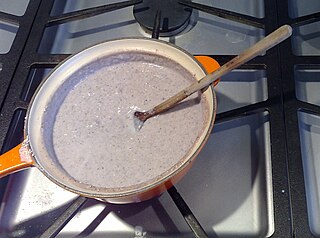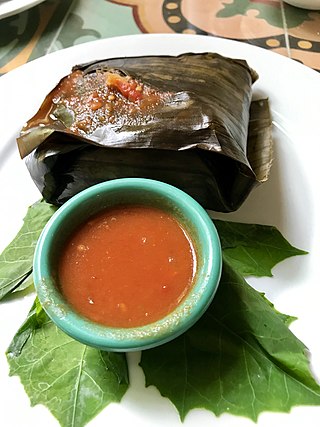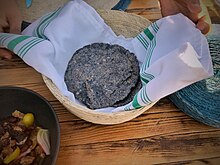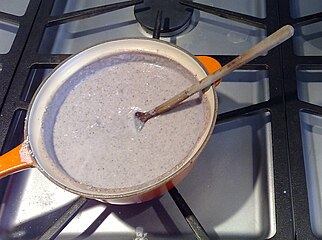
Hominy is a food produced from dried maize (corn) kernels that have been treated with an alkali, in a process called nixtamalization. "Lye hominy" is a type of hominy made with lye.

Mexican cuisine consists of the cooking cuisines and traditions of the modern country of Mexico. Its earliest roots lie in Mesoamerican cuisine. Its ingredients and methods begin with the first agricultural communities such as the Olmec and Maya who domesticated maize, created the standard process of nixtamalization, and established their foodways. Successive waves of other Mesoamerican groups brought with them their cooking methods. These included: the Teotihuacanos, Toltec, Huastec, Zapotec, Mixtec, Otomi, Purépecha, Totonac, Mazatec, Mazahua, and Nahua. With the Mexica formation of the multi-ethnic Triple Alliance, culinary foodways became infused.

In North America, a corn tortilla or just tortilla is a type of thin, unleavened flatbread, made from hominy, that is the whole kernels of maize treated with alkali to improve their nutrition in a process called nixtamalization. A simple dough made of ground, dried hominy, salt and water is then formed into flat discs and cooked on a very hot surface, generally an iron griddle called a comal.
Field corn, also known as cow corn, is a North American term for maize grown for livestock fodder, ethanol, cereal, and processed food products. The principal field corn varieties are dent corn, flint corn, flour corn which includes blue corn, and waxy corn.

Masa or masa de maíz is a maize dough that comes from ground nixtamalized corn. It is used for making corn tortillas, gorditas, tamales, pupusas, and many other Latin American dishes. It is dried and powdered into a flour form called masa harina. Masa is reconstituted from masa harina by mixing with water before use in cooking.

Pozole is a traditional soup or stew from Mexican cuisine. It is made from hominy with meat, and can be seasoned and garnished with shredded lettuce or cabbage, chilli peppers, onion, garlic, radishes, avocado, salsa or limes. Known in Mesoamerica since the pre-Columbian era, the stew is common across Mexico and neighboring countries, served both as a day-to-day meal and as a festive dish.

A tortilla chip is a snack food made from corn tortillas, which are cut into triangles and then fried or baked. Corn tortillas are made of nixtamalized corn, vegetable oil, salt and water. Although first mass-produced commercially in the U.S. in Los Angeles in the late 1940s, tortilla chips grew out of Mexican cuisine, where similar items were well known, such as totopos and tostadas.

Atole, also known as atolli, atol and atol de elote, is a traditional hot masa-based beverage of Mexican origin. Atole can have different flavors added such as vanilla, cinnamon, and guava. Chocolate atole is known as champurrado or atole. It typically accompanies tamales and is very popular during Day of the Dead and Las Posadas.

A tlacoyo is a Mexican dish of pre-Hispanic origin made of masa. Tlacoyos are thicker than fresh corn tortillas and are stuffed with cheese, fava beans, cooked ground beans, chicharron, and other ingredients before being fried or toasted. Tlacoyos can be served as an accompaniment to soups and stews or as appetizers for celebrations. They are made in varying shapes, most being oval and some also triangular.

Corn nuts, also known as toasted corn, are a snack food made of roasted or deep-fried corn kernels. It is referred to as cancha in Peru and chulpi in Ecuador.

New Mexican cuisine is the cuisine of the Southwestern US state of New Mexico. The region is primarily known for its fusion of Pueblo Native American cuisine with Hispano Spanish and Mexican cuisine originating in Nuevo México.

Ancient Maya cuisine was varied and extensive. Many different types of resources were consumed, including maritime, flora, and faunal material, and food was obtained or produced through strategies such as hunting, foraging, and large-scale agricultural production. Plant domestication concentrated upon several core foods, the most important of which was maize.

Most traditional foods in Guatemalan cuisine are based on Maya cuisine, with Spanish influence, and prominently feature corn, chilies and beans as key ingredients. Guatemala is famously home to the Hass avocado.
Tesgüino is an artisanal corn beer produced by several Yuto-Aztec people. The Tarahumara people regard the beer as sacred, and it forms a significant part of their society. Anthropologist John Kennedy reports that "the average Tarahumaras spends at least 100 days per year directly concerned with tesgüino and much of this time under its influence or aftereffects."

Maize, also known as corn in North American and Australian English, is a tall stout grass that produces cereal grain. It was domesticated by indigenous peoples in southern Mexico about 9,000 years ago from wild teosinte. Native Americans planted it alongside beans and squashes in the Three Sisters polyculture. The leafy stalk of the plant gives rise to male inflorescences or tassels which produce pollen, and female inflorescences called ears which yield grain, known as kernels or seeds. In modern varieties, these are usually yellow or white; other varieties can be of many colors.

Purple corn or purple maize is group of flint maize varieties originating in South America, descended from a common ancestral variety termed "kʼculli" in Quechua. It is most commonly grown in the Andes of Peru, Bolivia and Ecuador.

"Cacahuazintle" or "cacahuacintle" is the name of an old heirloom variety of white dent maize (corn) originating in Toluca, Mexico. It has a large ear with grains that are more white, round, and tender than the typical field corn grain. The dried grains are soaked and/or cooked in water with lime or wood ash, then rinsed thoroughly to remove the outer seed coat as well as any traces of the alkali salts —this is an ancient process called nixtamalization. This creates a fresh, wet hominy, which can be dried for later use or ground into a flour called masa. Masa can be used to make tortillas, tamales, atole, pozole, etc.

A tortilla is a thin, circular unleavened flatbread from Mesoamerica originally made from maize hominy meal, and now also from wheat flour.





















